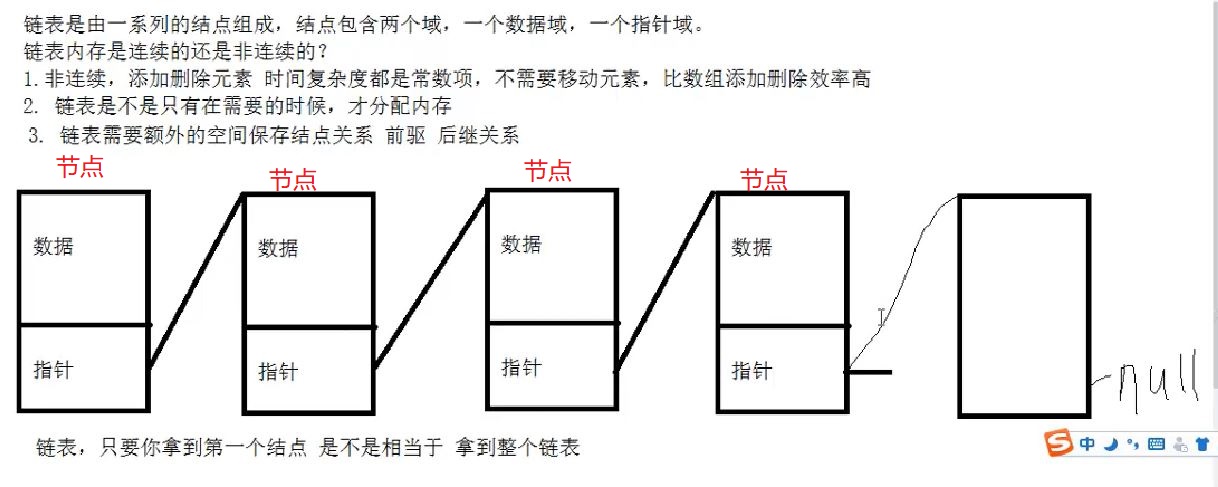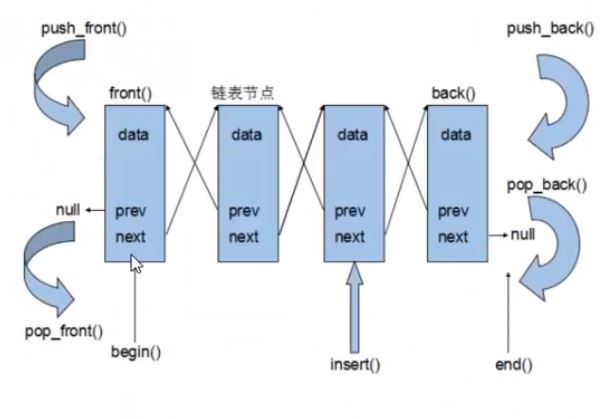



1 #include<iostream> 2 #include<list> 3 4 using namespace std; 5 // list 构造函数 6 void test01() 7 { 8 list<int> lst1; 9 lst1.push_back(10); 10 lst1.push_back(20); 11 lst1.push_back(30); 12 list<int> lst2(lst1);//拷贝构造函数 13 list<int> lst3(5, 10);//构造函数 14 list<int> lst4; 15 lst4.assign(lst3.begin(), lst3.end()); 16 } 17 18 // list 数据元素的插入与删除操作 19 void test02() 20 { 21 list<int> lst1; 22 lst1.push_back(30); 23 lst1.push_front(20);//20 30 24 lst1.insert(lst1.begin(), 10);//10 20 30 // 相当于 push_front 25 lst1.insert(lst1.end(), 40);//10 20 30 40 // 相当于 push_back 26 list<int>::iterator itr = lst1.begin(); 27 itr++; 28 itr++; 29 lst1.insert(itr, 999);//10 20 999 30 40 30 lst1.push_back(999); //10 20 999 30 40 999 31 auto itr_ = lst1.begin(); 32 itr_++; 33 lst1.erase(lst1.begin(), itr_);// [ , )左闭右开 20 999 30 40 999 34 lst1.remove(999);//删除容器中所有值为999的元素 20 30 40 35 } 36 int main() 37 { 38 test01(); 39 test02(); 40 return 1; 41 }
链表每个节点都有一个指针,结果是:链表插入与删除效率比线性表高,但是内存开销大,同时链表节点遍历相对线性表慢。
链表的c语言实现版本:
1 #include<iostream> 2 #include<set> 3 using namespace std; 4 5 class Node 6 { 7 public: 8 int data_;//数据阈 9 Node* next_;//指针阈 10 public: 11 Node():data_(-1), next_(nullptr) {} 12 }; 13 14 class List 15 { 16 public: 17 List() 18 { 19 this->head_ = new Node();// 不分配空间,下面赋值是不合理的! 20 //this->head_->data_ = 0;//多余? 21 this->head_->next_ = nullptr; 22 this->size_ = 0; 23 }; 24 void insert(int pos, int value); 25 void remove(int pos); 26 int get_reverse_element(int reverse_pos);//链表中倒数第k个节点 27 void reverse(); 28 29 int operator[](int i); 30 void print(); 31 ~List(); 32 33 34 public: 35 Node* head_; 36 int size_;//维护一个size 37 }; 38 //在第pos个元素前一个位置插入(创建、找到位置、入链表) 39 void List::insert(int pos, int value) 40 { 41 if (pos < 0 || pos > size_) 42 return; 43 44 //创建新的节点接受数据 45 Node* newnode = new Node(); 46 newnode->data_ = value; 47 //cout << "newnode->data_ = " << *newnode->data_ << endl; 48 newnode->next_ = nullptr; 49 50 //利用辅助指针找到pos前一个节点 51 // 其实这里不断next,无非就是希望p_curr = nullptr 52 // 然后56行 让newnode->next_ = nullptr(这个nullptr是从head_->next 传过来的);也就是尾部插入嘛 53 // 而循环链表 同理 让newnode->next_ = &(head_)(这个 &(head_) 是从head_->next 传过来的); 54 Node* p_curr = head_; 55 for (int i = 0; i < pos; i++) //这个for循环本质上是head_->next_->next_...... 56 { 57 p_curr = p_curr->next_; 58 } 59 //现在p_curr就是pos前一个节点的指针阈 60 //新节点入链表 61 newnode->next_ = p_curr->next_;//右边 62 p_curr->next_ = newnode;//左边 63 size_++; 64 } 65 66 void List::remove(int pos) 67 { 68 if (pos < 0 || pos > size_) 69 { 70 return; 71 } 72 Node* p_curr = head_; 73 for (int i = 0; i < pos; i++)// 3 74 { 75 p_curr = p_curr->next_; 76 } 77 p_curr->next_ = p_curr->next_->next_; 78 size_--; 79 } 80 81 //链表中倒数第k个节点 82 int List::get_reverse_element(int reverse_pos) 83 { 84 int pos = size_ - reverse_pos; 85 Node* p_curr = head_; 86 for (int i = 0; i < pos; i++) 87 { 88 p_curr = p_curr->next_; 89 } 90 return p_curr->data_; 91 } 92 93 //反转链表 94 void List::reverse() 95 { 96 // head -> 1 -> 2 -> 3 -> 4 -> nullptr 97 //nullptr <- 1 <- 2 <- 3 <- 4 98 99 Node* p_curr = head_->next_; 100 Node* p_prev = nullptr; 101 while (p_curr != nullptr) 102 { 103 Node* p_next = p_curr->next_; 104 if(p_curr->next_ == nullptr) 105 { 106 head_->next_ = p_curr; 107 } 108 p_curr->next_ = p_prev; 109 p_prev = p_curr; 110 p_curr = p_next; 111 } 112 } 113 114 int List::operator[](int i) 115 { 116 Node* p_curr = head_; 117 int count = 0; 118 while (count <= i) 119 { 120 p_curr = p_curr->next_; 121 count++; 122 } 123 return p_curr->data_; 124 } 125 void List::print() 126 { 127 if (size_ == 0) 128 { 129 cout << "size = 0" << endl; 130 return; 131 } 132 //遍历 133 Node* p_curr = head_->next_;//【注意这里next】 134 while (p_curr != nullptr) 135 { 136 cout << p_curr->data_ << " "; 137 p_curr = p_curr->next_; 138 } 139 cout << endl; 140 } 141 List::~List() 142 { 143 while (size_ != 0) 144 { 145 Node* p_curr = head_; 146 for (int i = 0; i < (size_ - 1); i++)// 012345 i < 5 147 { 148 p_curr = p_curr->next_;//for循环执行完,p_curr指向4 149 } 150 delete p_curr->next_;//删除最后一个元素 151 p_curr->next_ = nullptr;//末尾元素 空指针 152 size_--; 153 print(); 154 } 155 delete head_; //【这个容易忘记!】 156 cout << "delete!" << endl; 157 } 158 159 //合并两个排序链表 160 void mergeLists(List& list3, List& list4, List& list34) 161 { 162 Node* p_curr3 = list3.head_->next_; 163 Node* p_curr4 = list4.head_->next_; 164 Node* p_curr34 = list34.head_->next_; 165 int location = 0; 166 while ((p_curr3 != nullptr) || (p_curr4 != nullptr)) 167 { 168 if ((p_curr3 != nullptr) && (p_curr4 != nullptr)) 169 { 170 if (p_curr3->data_ < p_curr4->data_) 171 { 172 list34.insert(location, p_curr3->data_); 173 location++; 174 list34.insert(location, p_curr4->data_); 175 location++; 176 } 177 else 178 { 179 list34.insert(location, p_curr4->data_); 180 location++; 181 list34.insert(location, p_curr3->data_); 182 location++; 183 } 184 p_curr3 = p_curr3->next_; 185 p_curr4 = p_curr4->next_; 186 } 187 else if ((p_curr3 != nullptr) && (p_curr4 == nullptr)) 188 { 189 list34.insert(location, p_curr3->data_); 190 location++; 191 p_curr3 = p_curr3->next_; 192 } 193 else if ((p_curr3 == nullptr) && (p_curr4 != nullptr)) 194 { 195 list34.insert(location, p_curr4->data_); 196 location++; 197 p_curr4 = p_curr4->next_; 198 } 199 } 200 } 201 202 203 int main() 204 { 205 List list1; 206 //插入 207 for (int i = 0; i < 15; i++) 208 { 209 list1.insert(i, i); 210 } 211 212 //删除 213 list1.remove(10); 214 list1.remove(5); 215 //打印 216 list1.print(); 217 list1.reverse(); 218 list1.print(); 219 //访问倒数元素 220 for (int i = 1; i < 4; i++) 221 { 222 cout << "倒数第" << i << "个元素是:" << list1.get_reverse_element(i) << endl; 223 } 224 list1.insert(2, 9999); 225 //重载符[] 226 for (int i = list1.size_ - 1; i >= 0; i--) 227 { 228 cout << list1[i] << " "; 229 } 230 cout << endl; 231 List list2; 232 list2.insert(0, 10); 233 list2.insert(1, 20); 234 list2.insert(2, 30); 235 list2.print(); 236 int size2 = list2.size_; 237 238 //合并两个排序链表 239 List list3, list4; 240 for (int i = 0; i < 5; i++) 241 { 242 list3.insert(i, 2 * i); 243 list4.insert(i, 2 * i + 1); 244 } 245 list4.insert(5, 12); 246 list4.insert(6, 21); 247 list3.print(); 248 list4.print(); 249 250 List list34; 251 mergeLists(list3, list4, list34); 252 list34.print(); 253 254 255 return 1; 256 }